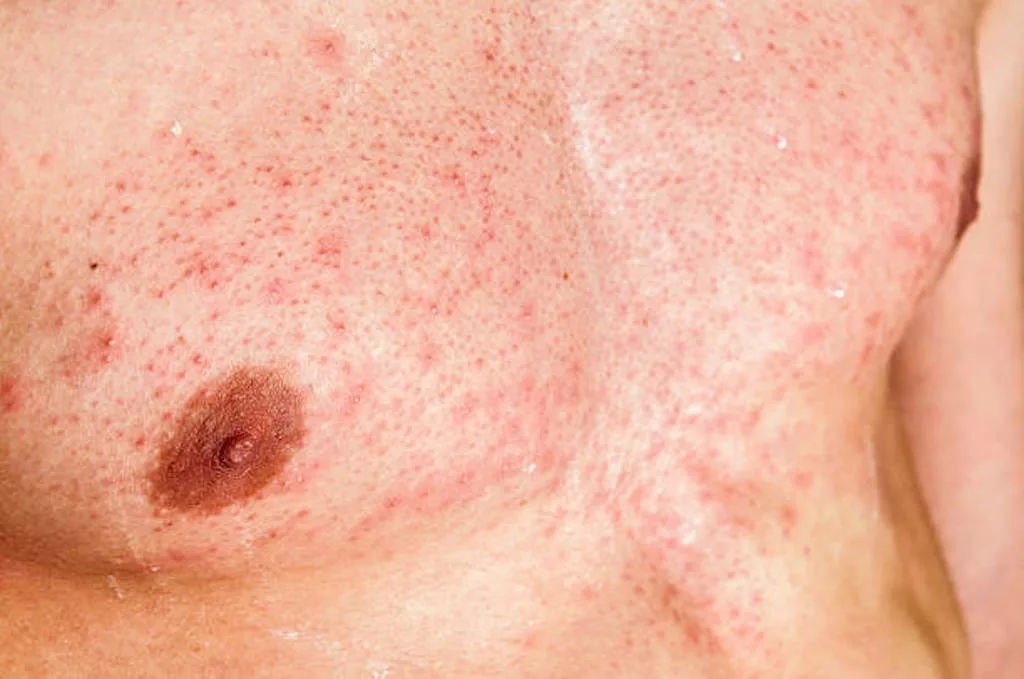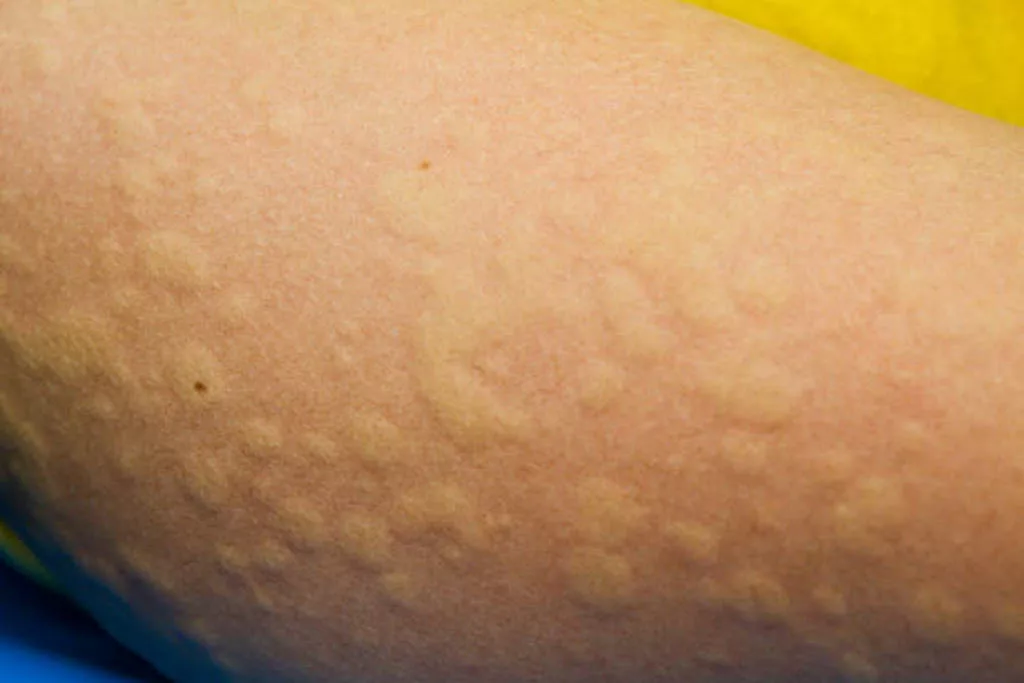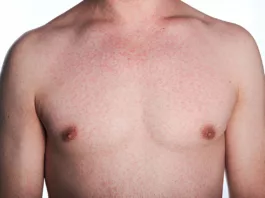Angioedema is a condition where fluid builds up deep under your skin or inside your body, which results in sudden swelling. When angioedema involves your throat, it can block your breathing and result in death.
What is Angioedema?
Angioedema is sudden, deep swelling in your skin or mucous membranes due to fluid leaking from small blood vessels. Doctors have been learning about this condition for a long time. Quincke first described the swelling back in 1882. Osler figured out that some people inherit it in families, calling it hereditary angioedema.
It’s estimated that up to 20 out of every 100 people may experience urticaria or angioedema at some point in their lives. The term “angioedema” comes from Greek, with “angeion” meaning “vessel” and “oidēma” meaning “swelling”. It refers to sudden swelling in areas like your:
- Lips
- Face
- Hands
- Feet
- Oral cavity
- Throat
- Gut
- Genitalia1Sánchez-Borges, M., Asero, R., Ansotegui, I. J., Baiardini, I., Bernstein, J. A., Canonica, G. W., Gower, R., Kahn, D. A., Kaplan, A. P., Katelaris, C., Maurer, M., Park, H. S., Potter, P., Saini, S., Tassinari, P., Tedeschi, A., Ye, Y. M., & Zuberbier, T. (2012). Diagnosis and Treatment of Urticaria and Angioedema: A Worldwide Perspective. World Allergy Organization Journal, 5(11), 125–147. https://doi.org/10.1097/wox.0b013e3182758d6c
How does Angioedema develop?
It takes place when fluid leaks out of your blood vessels and collects in the deeper layers of your skin and tissues. The mechanisms generally include:
Blood Vessel Leakage:
The process usually starts with vasodilation, which means the blood vessels under your skin widen. This is often a response to some kind of trigger, like an allergy, a drug, stress, or even a genetic issue. Widening the vessels increases blood flow but also makes it easier for fluid to escape.
Chemical Mediators:
In response to the trigger, your body releases chemical messengers such as:
- Histamine is released when the body reacts to an allergen. It causes your blood vessels to expand and become leaky. This leads to swelling, redness, and itching.
- In cases like hereditary angioedema, bradykinin builds up. This causes blood vessels to enlarge and leak. It results in swelling without an allergic trigger.
- These chemicals help histamine and bradykinin work together. They increase inflammation and prolong the swelling.
Role of C1 Inhibitor:
The C1 inhibitor is a protein in your body. It’s supposed to stop the spontaneous activation of inflammatory cascades. It does so by inactivating other particles like C1r, C1s, kallikrein, and factor XIIa. Without enough functional C1 inhibitor levels, bradykinin gets overproduced, which leads to angioedema.
What causes Angioedema?
This condition can happen for many different reasons. Its various triggers and causes include:
Genetics:
Hereditary angioedema means you’ve inherited a faulty gene that affects the C1-inhibitor protein in your body. Just one copy of the mutated gene from either parent is enough to cause it, since it’s an autosomal dominant disorder.
Allergies:
When you’re exposed to things like certain foods, insect stings, or medications, your body can release histamine in response. This makes your blood vessels widen, and fluid leaks into your tissues.
Drugs:
If you’re on ACE inhibitors or NSAIDs, these drugs can raise your bradykinin levels. That makes your vessels more relaxed and leaky, which leads to swelling. Opioid derivatives have also been linked with angioedema.
Infections:
When you’re fighting off a viral or bacterial infection, your immune system can go into overdrive. It releases chemicals like bradykinin that can cause fluid to leak out of your vessels.
Autoimmune Diseases:
If you have diseases like lupus or rheumatoid arthritis, your immune system can start attacking your own tissues. This sets off inflammation and makes your blood vessels more permeable.
Lymphoproliferative Disorders:
Conditions like lymphoma or CLL affect your white blood cells and mess with your immune regulation. This imbalance can cause abnormal fluid leakage and swelling.
Neoplastic Conditions:
Certain tumors release chemicals that either mimic immune signals or interfere with vessel control. This causes fluid buildup in your tissues.
Physical Triggers:
Exposure to heat, cold, pressure, or vibration can sometimes cause your skin to swell, especially if you have physical urticaria. The swelling is usually localized.2Memon, R. J., & Tiwari, V. (2023, August 8). Angioedema. Nih.gov; StatPearls Publishing. https://www.ncbi.nlm.nih.gov/books/NBK538489/

Types of Hereditary Angioedema
Hereditary angioedema is marked by a deficiency or dysfunction of the C1-inhibitor protein in the body. It is the most common type of angioedema. It has three types, with Type 1 being the most prevalent.3Kaplan, A. (2012). Type III hereditary angioedema: defined, but not understood. Annals of Allergy Asthma & Immunology, 109(3), 153–154. https://doi.org/10.1016/j.anai.2012.07.007
| Type | Features | C1 Inhibitor Level | C1 Inhibitor Function | C1q Level | C4 Level |
| Type 1 Hereditary | Your body does not produce enough C1 inhibitor. | Low | Decreased | Normal | Low, even between attacks |
| Type 2 Hereditary | Your body produces dysfunctional C1 inhibitor. | Normal or High | Decreased | Normal | Low |
| Type 3 Hereditary | Rare and usually estrogen-dependent, it is not related to any C1 inhibitor abnormality. | Normal | Normal | Normal | Normal |
Types of Acquired Angioedema
Acquired angioedema is characterized by recurrent episodes of swelling, which is often a result of overproduction of bradykinin or histamine. Bradykinin-mediated acquired angioedema is usually due to a deficiency or inactivation of C1 inhibitor protein, which happens later in life. Meanwhile, histamine-mediated acquired angioedema is triggered by allergens and is commonly associated with urticaria.
Typically, acquired angioedema presents in adults without a family history of angioedema. Labs usually show low levels of C1 and functional C1, unlike hereditary angioedema. C1q levels can be lower. Examples include:
Acquired Angioedema Type 1:
In type 1, your C1 inhibitor protein is used up too quickly, often because of an autoimmune disease or tumor. This causes an overactive immune response. With low C1 inhibitor protein levels, bradykinin levels rise, and u may experience repeated swelling episodes. Tests will show reduced C1 inhibitor levels.
Acquired Angioedema Type 2:
In type 2, your body produces antibodies that interfere with the normal function of the C1 Inhibitor protein. This disrupts its ability to control bradykinin and results in swelling. Although C1 Inhibitor protein levels may appear normal, its function will be low.
ACE Inhibitor-Induced Angioedema:
If you’re on ACE inhibitors for high blood pressure or heart failure, you may experience angioedema as a side effect. ACE inhibitors work by preventing the breakdown of bradykinin. If you’re African American or have a history of smoking, your risk may be higher. The swelling usually goes away when ACE inhibitors are stopped.
NSAID-Induced Angioedema:
You might experience this condition if you take NSAIDs, which include commonplace painkillers like ibuprofen. If you have asthma or a history of allergies, you’re more likely to develop this reaction. The swelling typically resolves once you stop taking the NSAID.
IgE-Mediated Allergic Acquired Angioedema:
Your immune system may release IgE antibodies that cause angioedema. This happens when your body reacts to an allergen by releasing histamine and other chemicals. You’ll likely experience other allergy symptoms, like hives or itching.
Idiopathic Acquired Angioedema:
In some cases, the cause isn’t clear. This is known as idiopathic acquired angioedema. Despite testing, no underlying cause is found, and the condition is diagnosed after ruling out other possibilities. You may experience unpredictable swelling that comes and goes.4Swanson, T. J., & Patel, B. C. (2023, August 14). Acquired Angioedema. Nih.gov; StatPearls Publishing. https://www.ncbi.nlm.nih.gov/books/NBK430889/
What are the symptoms of Angioedema?
This condition often has a presentation that can be mistaken for simple allergic reactions, so it needs to be caught early. Signs and symptoms include:
- You might notice sudden swelling around your eyes, lips, hands, feet, or genitals. The swollen area does not leave a dent when pressed, which means it is a form of non-pitting edema. Swelling usually goes away on its own within 24 to 48 hours.
- Your skin may appear normal or slightly red, and you may feel a burning or tight sensation instead of itching. There are no blisters, oozing, or peeling like in eczema.
- If your intestines are involved, you might feel abdominal pain or cramps.
- If your throat or tongue swells, you may find it hard to breathe or swallow, and this can be serious.
- You might also get hives or urticaria. These are raised, itchy, red or purplish patches on your skin, commonly associated with severe allergic reactions.5Fernandez, J. (2024, August 2). Angioedema. MSD Manual Professional Edition; MSD Manuals. https://www.msdmanuals.com/professional/immunology-allergic-disorders/allergic-autoimmune-and-other-hypersensitivity-disorders/angioedema
How is Angioedema diagnosis established?

Angioedema mimics various disorders, so it is important to diagnose it early. Steps to the diagnosis include a physical assessment and lab tests.
History & Physical Exam:
A diagnosis starts with a thorough history and physical exam. You’ll be asked when the swelling began, how often it occurs, how long it lasts, and what areas are affected. You’ll also be asked about your allergies and if you’ve been stressed lately.
Your doctor will examine you for swelling and lumps. If the swelling keeps coming back without any rash or itchiness, they may consider non-allergic or hereditary types of angioedema. Priority will be given to any swelling blocking your airways, as this can be life-threatening.

Lab Tests:
After the physical assessment, you’ll undergo a range of lab tests to narrow down the type and cause.
- A CBC checks for signs of infection or inflammation.
- Liver function tests and renal function tests help rule out organ dysfunction.
- An allergy panel is ordered to detect IgE-mediated allergies.
- C4 levels are usually low in hereditary and acquired C1 inhibitor deficiency.
- C1 inhibitor protein levels are decreased in type 1 hereditary angioedema and normal or elevated in type 2.
- C1 inhibitor functional activity measures how well the inhibitor is working, and this is reduced in both type 1 and type 2 forms.
- C1q levels are used to differentiate between hereditary and acquired types. They are usually normal in hereditary angioedema but low in acquired forms.
- Serum tryptase may be tested if mast cell activation (like in anaphylaxis or severe allergies) is suspected, as the levels will be raised.
Imaging:
In some cases, imaging is needed to evaluate deeper swelling or internal organ involvement.
- An ultrasound can check for swelling or fluid accumulation, especially in the abdomen.
- A CT scan can be useful if your angioedema involves the airway, gastrointestinal tract, or if the cause is unclear.6Li, H. (2025, February 6). Angioedema: Practice Essentials, Background, Pathophysiology. Medscape.com; Medscape. https://emedicine.medscape.com/article/135208-overview
What is the treatment of Angioedema?
Mild cases of angioedema can resolve on their own within a few days. However, severe cases can be life-threatening, so treatment is often needed even for mild symptoms.
Medications:
Medications are the first-line treatment for this condition. These include:
- Antihistamines block histamine release and are usually the first treatment your doctor will try, especially if you also have hives.
- Corticosteroids like prednisone reduce inflammation and swelling. Your doctor will likely use them only for a short period to avoid long-term side effects.
- Epinephrine is used in life-threatening allergic reactions to quickly stop swelling and prevent your airway from closing.
- C1 esterase inhibitors replace the missing protein in hereditary angioedema and help reduce swelling when it’s triggered. This treatment is especially important for people with Type 1 and Type 2 hereditary angioedema.
- Ecallantide works by inhibiting kallikrein in hereditary angioedema to prevent attacks and reduce swelling.
- Fresh frozen plasma may be used in drug-induced angioedema and hereditary angioedema to restore missing proteins and decrease swelling.
- Danazol is a synthetic steroid used for long-term management of hereditary angioedema. It helps increase the production of C1 inhibitor protein. It also reduces the frequency and severity of attacks.
- Tranexamic acid helps stabilize blood clots and is sometimes used for patients with hereditary angioedema to prevent attacks.
- Icatibant is a bradykinin receptor antagonist used in the treatment of acute attacks of hereditary angioedema. It blocks the effects of bradykinin.
Emergency Treatment of Angioedema :
If angioedema affects your airway, it becomes a medical emergency. You should never wait it out at home, and should seek urgent medical attention:
- If your throat is closing up because of swelling, you may need a shot of epinephrine right away to stop the swelling before it worsens.
- In rare but serious cases, doctors may need to insert a breathing tube into your windpipe or perform a tracheostomy. In this procedure, they cut open your windpipe through your neck to keep you alive and breathing.
- After an emergency episode, you’ll be monitored closely to make sure your symptoms don’t come back or get worse. Doctors might give you more medications, oxygen, or fluids during this time.
Supportive Care:
Once the emergency is over and your symptoms are under control, the focus is on long-term management and prevention of further episodes.
- You’ll need to identify and avoid whatever triggered your angioedema, such as foods or medications.
- In case you’ve had a serious episode before, you should carry an epinephrine auto-injector with you at all times pisses.
- Your doctor might send you to a specialist like an allergist or immunologist to better understand and manage your condition.
- Regular checkups will help monitor your symptoms and adjust your treatment plan as needed.7Green, T. E. (2024, October 29). Acute Angioedema: Overview of Angioedema Treatment, Prehospital Care, Emergency Department Care. Medscape.com; Medscape. https://emedicine.medscape.com/article/756261-overview
Angioedema Vs. Anaphylaxis
Angioedema is a condition where swelling occurs in the deeper layers of the skin and mucosal tissues. It is often limited to the skin around your facial parts and abdominal/pelvic organs. On the other hand, anaphylaxis is a sudden and severe allergic reaction. It affects multiple systems in the body. Anaphylaxis is life-threatening within minutes as it can cause your heart and lungs to stop working within a few minutes. Angioedema is often seen accompanying such severe allergic reactions.8GP Spickett, & Stroud, C. (2011). Does this patient with urticaria/angioedema have anaphylaxis? Clinical Medicine, 11(4), 390–396. https://doi.org/10.7861/clinmedicine.11-4-390
Conclusion
Angioedema is a serious condition that causes sudden swelling, often around your eyes, lips, or throat. It can happen because of allergies, certain medications, or inheritance. While some of such cases go away on their own, others can be life-threatening and need emergency treatment. Prevention of recurrent episodes includes avoiding triggers and continuing supportive care.
Refrences
- 1Sánchez-Borges, M., Asero, R., Ansotegui, I. J., Baiardini, I., Bernstein, J. A., Canonica, G. W., Gower, R., Kahn, D. A., Kaplan, A. P., Katelaris, C., Maurer, M., Park, H. S., Potter, P., Saini, S., Tassinari, P., Tedeschi, A., Ye, Y. M., & Zuberbier, T. (2012). Diagnosis and Treatment of Urticaria and Angioedema: A Worldwide Perspective. World Allergy Organization Journal, 5(11), 125–147. https://doi.org/10.1097/wox.0b013e3182758d6c
- 2Memon, R. J., & Tiwari, V. (2023, August 8). Angioedema. Nih.gov; StatPearls Publishing. https://www.ncbi.nlm.nih.gov/books/NBK538489/
- 3Kaplan, A. (2012). Type III hereditary angioedema: defined, but not understood. Annals of Allergy Asthma & Immunology, 109(3), 153–154. https://doi.org/10.1016/j.anai.2012.07.007
- 4Swanson, T. J., & Patel, B. C. (2023, August 14). Acquired Angioedema. Nih.gov; StatPearls Publishing. https://www.ncbi.nlm.nih.gov/books/NBK430889/
- 5Fernandez, J. (2024, August 2). Angioedema. MSD Manual Professional Edition; MSD Manuals. https://www.msdmanuals.com/professional/immunology-allergic-disorders/allergic-autoimmune-and-other-hypersensitivity-disorders/angioedema
- 6Li, H. (2025, February 6). Angioedema: Practice Essentials, Background, Pathophysiology. Medscape.com; Medscape. https://emedici
- 7Green, T. E. (2024, October 29). Acute Angioedema: Overview of Angioedema Treatment, Prehospital Care, Emergency Department Care. Medscape.com; Medscape. https://emedicine.medscape.com/article/756261-overview
- 8GP Spickett, & Stroud, C. (2011). Does this patient with urticaria/angioedema have anaphylaxis? Clinical Medicine, 11(4), 390–396. https://doi.org/10.7861/clinmedicine.11-4-390





